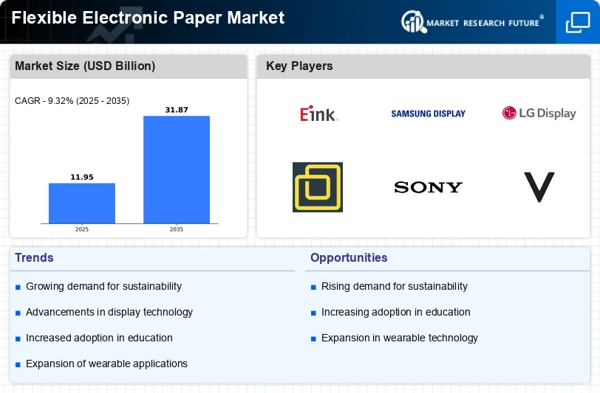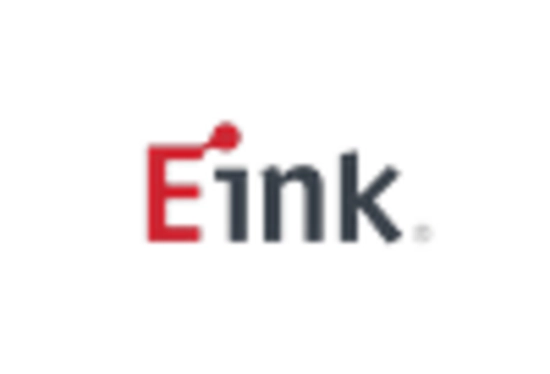Technological Innovations
Technological advancements are likely to play a crucial role in shaping the Flexible Electronic Paper Market. Innovations in materials science and display technologies have led to the development of more efficient and versatile electronic paper solutions. For instance, advancements in organic light-emitting diodes (OLEDs) and electrophoretic displays have improved the performance and functionality of flexible electronic paper. Market data suggests that the integration of these technologies could lead to a compound annual growth rate (CAGR) of over 15% in the coming years. As manufacturers continue to invest in research and development, the potential for enhanced applications in various sectors, including education and advertising, becomes increasingly apparent.
Sustainability Initiatives
The increasing emphasis on sustainability appears to be a pivotal driver for the Flexible Electronic Paper Market. As consumers and businesses alike become more environmentally conscious, the demand for eco-friendly alternatives to traditional paper products is surging. Flexible electronic paper, which utilizes less energy and resources in its production, aligns well with these sustainability initiatives. Reports indicate that the market for sustainable materials is projected to grow significantly, with flexible electronic paper potentially capturing a substantial share. This shift not only reflects changing consumer preferences but also encourages manufacturers to innovate and adopt greener practices, thereby enhancing the overall appeal of the Flexible Electronic Paper Market.
Integration with Smart Devices
The integration of flexible electronic paper with smart devices appears to be a significant driver for the Flexible Electronic Paper Market. As the Internet of Things (IoT) continues to expand, the demand for seamless connectivity between devices is growing. Flexible electronic paper can serve as an ideal medium for displaying information in real-time, enhancing user experience across various applications. Market analysis indicates that the smart device sector is expected to witness substantial growth, with flexible electronic paper potentially becoming a preferred choice for interactive displays. This integration not only enhances functionality but also opens new avenues for innovation within the Flexible Electronic Paper Market.
Consumer Demand for Versatility
The rising consumer demand for versatile and multifunctional products is likely to propel the Flexible Electronic Paper Market forward. As users seek solutions that can adapt to various needs, flexible electronic paper offers unique advantages, such as lightweight design and the ability to display dynamic content. This versatility is particularly appealing in sectors like retail, where businesses are increasingly looking for innovative ways to engage customers. Market trends suggest that the demand for adaptable display solutions is on the rise, with flexible electronic paper poised to meet these evolving needs. Consequently, manufacturers are encouraged to explore diverse applications, further driving growth in the Flexible Electronic Paper Market.
Cost-Effectiveness of Production
The cost-effectiveness of producing flexible electronic paper is emerging as a key driver for the Flexible Electronic Paper Market. As production techniques improve and economies of scale are realized, the overall costs associated with manufacturing flexible electronic paper are decreasing. This reduction in costs not only makes the technology more accessible to a broader range of consumers but also encourages businesses to adopt flexible electronic paper solutions. Market forecasts indicate that as production costs continue to decline, the adoption rate of flexible electronic paper in various applications, such as signage and packaging, is likely to increase. This trend underscores the potential for growth within the Flexible Electronic Paper Market.

















Leave a Comment